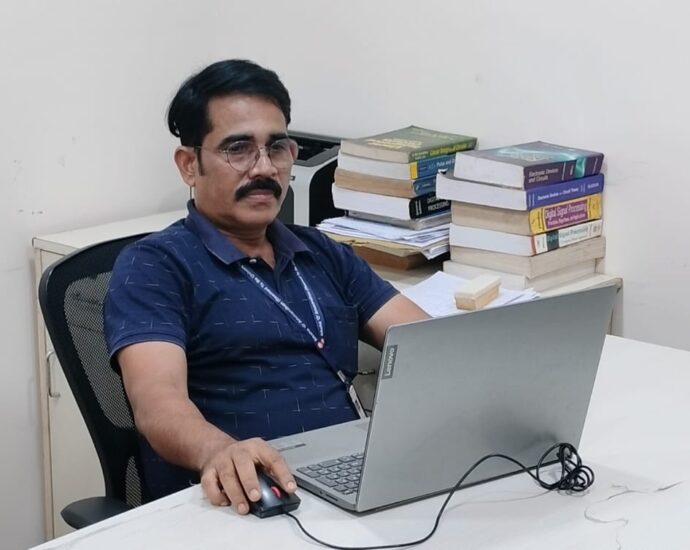Dr. Hemanta Kumar Palo completed his ‘A.M.I.E. (B-Tech)’ from the Institute of Engineers, India in 1997, his Master of Engineering from Birla Institute of Technology, Mesra, Ranchi in 2011, and his Ph.D. in 2018 from the Siksha ‘O’ Anusandhan (Deemed to be University), Bhubaneswar, Odisha, India respectively. He served 20 years in Indian Air Force and 13 years of teaching experience in the field of Electronics and Communication Engineering respectively. Currently, he is serving as an Associate Professor in the Department of Electronics and Communication Engineering at the Institute of Technical Education and Research, Siksha ‘O’ Anusandhan University, Bhubaneswar, Odisha, India.
Dr. Hemanta Kumar Palo is a life member of IEI, India, and is a member of IEEE. He is the recipient of SIKSHASREE SANMAN-2017 by the Saheed Raghu-Divakar Smruti Sansad, Bhubaneswar, Odisha. SIKSHYARATNA-2017, by Rajyastariya Mother Teresa Jayanti Samaroh, Bhubaneswar, Outstanding Researcher Award, International Institute of Organized Research (I2OR) Award, 2017.
In the area of research, Dr. Hemanta Kumar Palo has published around 75 research papers in highly indexed international and national journals and conferences. He is a review Editor in Frontiers High-Performance Computing Parallel and Distributed Software. His area of research includes signal processing, power quality disturbance analysis, and speech and emotion recognition. He has organized several IEEE and Springer international conferences in the field of signal and image processing, power electronics, soft computing, electrical, electronics, swarm computing, etc.
Some of his work includes “The amalgamation of Wavelet Packet Information Gain Entropy Tuned Source and System Parameters for Improved Speech emotion recognition. Speech Communication,149, 11-28, Elsevier, 2023”, “Effective recognition of facial emotions using dual transfer learned feature vectors and support vector machine. International Journal of Information Technology, 15(1), 301-313, Springer 2023, “Modeling of human mood states from voice using adaptively tuned neuro-fuzzy inference system. Serbian Journal of Electrical Engineering, 20(1), 13-32, 2023”, “K-nearest neighbor based facial emotion recognition using effective features. IAES International Journal of Artificial Intelligence, 12(1), 57, 2023”, “Power Quality Disturbance Classification using Vector Quantized Eigen Matrix and Cost-Sensitive Decision Tree Network. International Journal on Electrical Engineering & Informatics, 14(4), 2022”, “Classification of Power Quality Disturbances using Wavelet Packet Information Entropy Feature Vectors and Probabilistic Neural Network. International Journal on Electrical Engineering and Informatics, 13(4), 839-852, 2021”, “Child emotion recognition using a probabilistic neural network with effective features. Measurement, 152, 107369, Elsevier 2020”, “Segment-based emotion recognition using combined reduced features. International Journal of Speech Technology, 22(4), 865-884, Springer 2019”, “Wavelet-based feature combination for recognition of emotions. Ain shams engineering journal, 9(4), 1799-1806, Elsevier 2018”, “Speech emotion analysis of different age groups using clustering techniques. International Journal of Information Retrieval Research (IJIRR), 8(1), 69-85, 2018”, “Emotion recognition using MLP and GMM for the Oriya language. International Journal of Computational Vision and Robotics, 7(4), 426-442, Inderscience 2017”, “Efficient feature combination techniques for emotional speech classification. International journal of speech technology, 19, 135-150, Springer 2016”, “Performance analysis of emotion recognition from speech using combined prosodic features. Advanced Science Letters, 22(2), 288-293, IOP Science 2016”, “Efficient feature extraction for fear state analysis from the human voice. Indian Journal of Science & Technology, 9(38), 1-11, 2016”, “Modified-VQ features for speech emotion recognition. Journal of Applied Sciences, 16(9), 406-418, 2016”, “Classification of emotional speech of children using probabilistic neural network. International Journal of Electrical and Computer Engineering (IJECE), 5(2), 311-317, 2015, IAES”, “Recognition of Anger, Irritation, and Disgust Emotional States based on Similarity Measures. Indian Journal of Science and Technology, 9, 38, 2016”, “An Adaptive Method for Emotional Speech Enhancement and Recognition Using PNN. International Journal of Control Theory and Applications, 8(5), 2395-2403, International Science Press, 2015”, “Speech Coding Techniques: A Comparative Study. International Journal of Electronics & Communication Technology, IJECT,
2023-06-21

